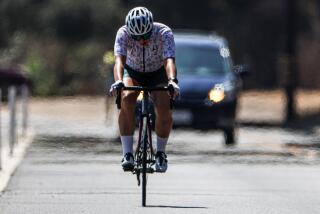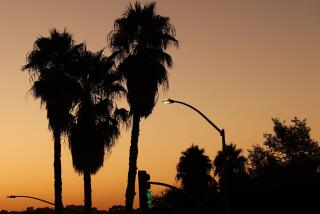And There’s More to Come : 106! It’s the Hottest April Day Ever Recorded in L.A.
- Share via
Sweltering residents coped as best they could Thursday--heading for the beach, escaping to air conditioning, seeking out shade and squirting each other with hoses--as Southern California wilted under the third day of a persistent, record-shattering heat wave.
It was 106 degrees at the Los Angeles Civic Center on Thursday, the hottest day so far this year and the hottest April day on record. That toppled the old record for the date, set in 1962, by 15 degrees. It was the third day in a row that downtown readings topped the 100-degree mark.
El Toro in Orange County, where the mercury climbed to 112, was the hottest spot in the country. Other Southland area readings included 110 in Ontario, 107 in Monrovia and Palm Springs, and 105 in Long Beach, Westwood, Pasadena and Northridge.
Nighttime temperatures remained at record high levels too. Thursday’s minimum reading at the Civic Center, recorded shortly before dawn, was 73 degrees, 11 degrees above the 59-year-old record for the date.
The weather was as dry as it was hot, with relative humidity ranging from a barely discernible 8% to a merely arid 34%.
“And there really won’t be any relief until next week,” said Pat Cooper, a meteorologist with WeatherData Inc., which provides forecasts for The Times.
“There will be more heat Friday, in the low 100s from downtown, out through the valleys and into the deserts,” she said. “Saturday will still be very warm, with more 100s downtown and in the valleys. Sunday will be just a little bit cooler, near 100. . . .
“It shouldn’t really begin abating until about Monday or Tuesday, when the highs will begin easing off into the 90s. And there’s no sign of rain at all.”
Despite the oppressive heat, hospitals reported no noticeable surge in heat-related illnesses. But there were other problems--stalled cars, closed schools, seared gardens, record power use and heat-related blackouts.
And medical experts warned of potentially serious consequences for those who must go out in the heat and the sun.
“Play it cool,” advised Dr. Edwin Newtown, a physician on duty in the emergency ward at County-USC Medical Center.
That was fine if you went to the beach, where lifeguards said more than 200,000 flocked to the sand and some of the more courageous tried a swim in the 61-degree water.
But if you wanted to take a dip in one of Los Angeles County’s 38 public pools, you were pretty much out of luck. All but one were closed Thursday afternoon.
“They’re not open right now, because they’re not year-around pools,” explained Frank Tamayo, a pool supervisor for the county. Most of the county-run pools will open only after the school year ends in June, he said.
Not surprisingly, a long line of people, mostly young children, formed at the only county-run pool open to the public, the Roosevelt Park Pool in Florence, near Huntington Park.
Lifeguard Ray Sandoval, 20, said it was so crowded in the early afternoon that he had to empty the pool of swimmers at 2:30 p.m. so he could give the people waiting outside a chance.
“I couldn’t wait to get out of school,” said a relieved Jaime Perez, 11, after he jumped into the water at 3 p.m. “The air conditioner didn’t work and the fan wouldn’t work either.”
Three concrete-truck drivers at the downtown construction site of the new State Building sprinkled each other with water from the trucks’ 100-gallon water tanks while waiting in the sun to unload.
“I’ve been waiting here an hour,” said 37-year-old Dale Johnson as he stood beside his truck at 3rd and Main streets, squinting into the glaring sun. “You’ve got to do something.”
Half a block down Main Street, Elton Thomas, 56, took what refuge he could under the narrow awning of his shoeshine stand as he continued to buff a customer’s boots.
“Yeah, it sure is hot,” Thomas said, mopping his brow. “But you’ve got to keep working, no matter what happens. You can’t let the weather keep you from eating.”
Cars overheated and fizzled out on Los Angeles freeways Thursday in what Sgt. Mike Brey of the California Highway Patrol described as a “vicious circle.”
“Sometimes when they overheat, they’re stuck in the fast lane,” he said. “That slows traffic and that makes even more people heat up.”
The problem was especially acute Thursday in the downtown area, where converging freeways were sporadically jammed with stranded, sweating motorists.
Brey offered one piece of advice that might not be popular, but it can keep your car from overheating: When stalled in traffic, turn off your air conditioner.
People turning up air conditioners in homes, businesses and public buildings pushed electrical consumption to near record levels for the third straight day.
Southern California Edison Co. officials said a peak of 15,101 megawatts was being used by 4 p.m., eclipsing the previous high set the day before of 14,282. Edison’s all-time high is 15,987 megawatts, set Sept. 6 when the temperature reached 110 degrees.
The Los Angeles Department of Water and Power also reported a new high for April of 4,785 megawatts, beating the mark set Wednesday of 4,541. DWP’s all-time high of electricity use--4,991--was also set Sept. 6.
As the temperatures soared, DWP officials asked customers to delay the use of heat-producing appliances, such as stoves and dryers, until the evening hours.
“Their use reduces the ability of air conditioning to cool a house during the day,” DWP spokeswoman Mindy Berman said.
Scattered power outages were reported.
The DWP’s Ed Freudenberg said circuits overloaded by air conditioning caused a power loss to about 1,000 customers in the Westwood area Wednesday night. The power was restored before dawn, but at 9:20 a.m. Thursday about 800 of the same customers lost power again.
Officials said none of the other outages were immediately linked to the record demands for electricity.
The heat hampered city firefighters battling two small brush fires of unknown origin near the interchange of the San Bernardino and Golden State freeways in Boyle Heights. Several freeway transition roads were closed for about an hour while firefighters extinguished the blaze.
Some schools in the Los Angeles Unified School District let students out of classes early Thursday because of the heat, and others said they planned shortened schedules for today.
“The rooms are boiling, they’re cooking,” said third-grade teacher Fay Rosenthal, whose classroom at the San Jose Street Elementary School in Woodland Hills reached 99 degrees Thursday. Like most campuses in the district, the school is not air-conditioned.
“I sent home three children with stomach aches, which I presume comes from (drinking too much) water,” Rosenthal said. “All the teachers have that problem. They’re sending children home because they can’t cope.”
An official at the San Jose Street school said students would be taking notes home notifying parents that class will be dismissed today at 1:55 p.m. instead of the usual 2:30 p.m.
Dr. Newton advised those who have to go out in the sun simply to “use common sense. . . .
“Limit your exposure to the sun,” he said. “Don’t fall asleep out there, or you can get into a lot of trouble.
“Drink lots of cool liquids. Use plenty of sun-block tanning lotion. If you feel headache or nausea, get into the shade and cool down.”
Newton said that in addition to sunburn, which can be serious enough to require hospitalization, there are three types of problems that can result from the heat.
The first, he said, involves heat cramps, which can usually be remedied by drinking water or an electrolyte, like Gatorade.
“More serious,” he said, “is heat exhaustion, where the body is significantly dehydrated. You feel exhausted. If that happens, start drinking water, get out of the sun and wet yourself.”
The most serious, he said, is a heat stroke, which can cause the victim to collapse and often results in permanent brain damage.
“If that happens, call 911,” he said. “You need help right away.”
Homeowners throughout the basin fretted over their sun-parched gardens Thursday. Cliff Comstock, an executive at the huge Monrovia Nursery in Azusa, advised frequent, rather than heavy, watering, preferably done in the evening or early in the morning.
“If you water in the middle of the day, you can scorch the foliage,” he said.
Times staff writers Elaine Woo and George Ramos contributed to this article.
More to Read
Sign up for Essential California
The most important California stories and recommendations in your inbox every morning.
You may occasionally receive promotional content from the Los Angeles Times.











